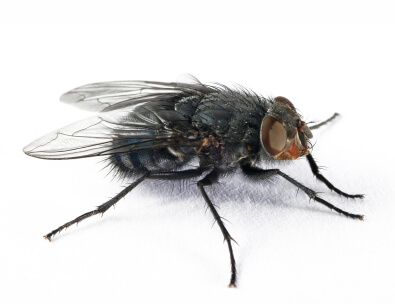Flies
Distribution:
This common fly originated on the steppes of Central Asia, but now occurs on all inhabited continents, in all climates from tropical to temperate, and in a variety of environments ranging from rural to urban. It is commonly associated with animal feces, but has adapted well to feeding on garbage, so it is abundant almost anywhere people live.


Life Cycle and Description:
The house fly has a complete metamorphosis with distinct egg, larva or maggot, pupal and adult stages. The house fly overwinters in either the larval or pupal stage under manure piles or in other protected locations. Warm summer conditions are generally optimum for the development of the house fly, and it can complete its life cycle in as little as seven to ten days. However, under suboptimal conditions the life cycle may require up to two months. As many as 10 to 12 generations may occur annually in temperate regions, while more than 20 generations may occur in subtropical and tropical regions.
Adults usually live 15 to 25 days, but may live up to two months. Without food, they survive only about two to three days. Longevity is enhanced by availability of suitable food, especially sugar. Access to animal manure does not lengthen adult life and they live longer at cooler temperatures. They require food before they will copulate, and copulation is completed in as few as two minutes or as long as 15 minutes. Oviposition commences four to 20 days after copulation. Female flies need access to suitable food (protein) to allow them to produce eggs, and manure alone is not adequate. The potential reproductive capacity of flies is tremendous, but fortunately can never be realized. Scientists have calculated that a pair of flies beginning reproduction in April may be progenitors, under optiminal conditions and if all were to live, of 191,010,000,000,000,000,000 flies by August. The flies are inactive at night, with ceilings, beams and overhead wires within buildings, trees, and shrubs, various kinds of outdoor wires, and grasses reported as overnight resting sites.
Sanitation or cultural control:
Good sanitation is the basic step in any fly management program. Food and materials on which the flies can lay eggs must be removed, destroyed as a breeding medium, or isolated from the egg-laying adult. Since the house fly can complete its life cycle in as little as seven days, removal of wet manure at least twice a week is necessary to break the breeding cycle. Wet straw should not be allowed to pile up in or near buildings. Since straw is one of the best fly breeding materials, it is not recommended as bedding. Spilled feed should not be allowed to accumulate but should be cleaned up two times a week. Ordinarily, fly control from 1 to 2 km around a municipality prevents house fly infestations.
Chemical control:
When the house fly is a mayor pest in commercial egg production facilities, the control of this insect is by the application of adulticides, or larvicides to directly or indirectly suppress adult densities. Residual wall sprays can be applied where the flies congregate. Resistance to permethrin develops more rapidly in fly populations from farms on a continuous permethrin regime than in farms in which permethrin and diclorvos have been alternated. Outdoors, the control of flies includes the use of boric acid in the bottom of dumpsters, treatment of vertical walls adjacent to dumpsters and other breeding sites with microencapsulated or wettable powder formulation, and the use of fly baits near adult feeding sources.
